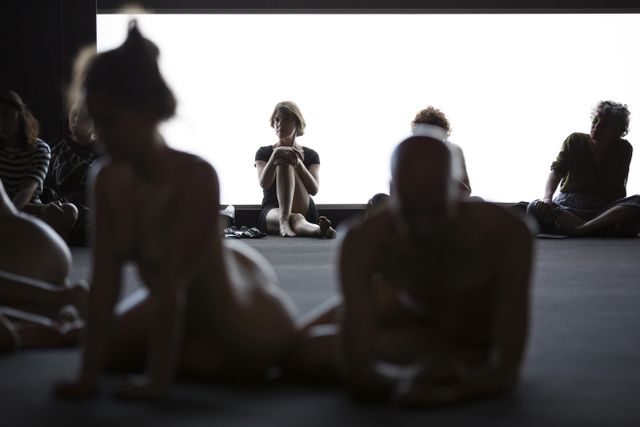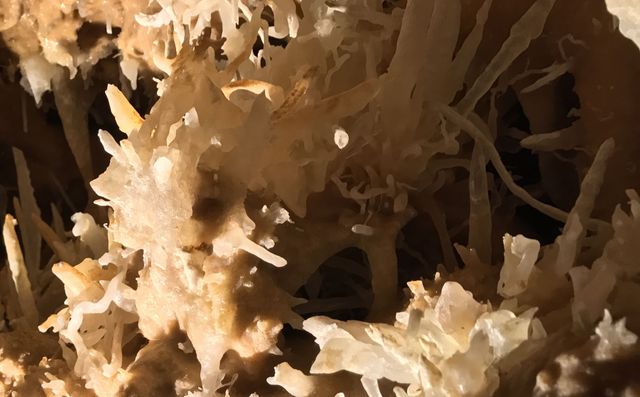Life as Search Term
An interview with Xavier Le Roy and Sophia Roosth, facilitated by Sascha Pohflepp
Conversations entwined with artistic and performative strategies form the structure of the three-day program Life Forms: Amidst a choreographic work by Xavier Le Roy and Scarlet Yu, Sophia Roosth explores the spectrum of meanings of the term “life forms” in a series of research talks. In an interview with the artist and researcher Sascha Pohflepp, the science historian and the choreographer discuss how their contributions challenge our understanding of life and which forms it can take on. A conversation about artificial intelligence that reaches human limits, genetic algorithms and transformative performances.
Sascha Pohflepp: The concept of life has been shifting throughout history. Are we then perhaps not actually looking for life but instead searching for something else, for which “life” might be the placeholder – like a search term?
Sophia Roosth: One of the things I’m continually struck by is how much the question of “What is life?” has changed, even in the last 200 years. From the idea of life as the series of functions that are resistant to death to life as a negative entropy: life has always been defined by its limits and antonyms such as the inanimate or inorganic. In the current moment, I think so much of what has counted as life is delaminating from context. This is partly because of genomics and the ways in which computing and big data have been enrolled into the life sciences. When life becomes this slippery category, people fashion new forms and definitions of life by reference to new things that may or may not count as life. In relation to this, form can become a proxy for all sorts of other things, like complexity or pattern. Form and life have run against one another, and their definitions have merged and then pulled apart at particular moments throughout the history of biology and the life sciences.
Xavier Le Roy: I like this idea of life as a search term. My understanding of life is something that always involves a process of transformation.
Sascha Pohflepp: Sophia, since you are an anthropologist of science now teaching as a historian of science, and Xavier, you are a molecular biologist by training now working as a choreographer, how did you end up working on life forms? Where did the idea come from and how will you each work with it in your contributions for the event at HKW?
Sophia Roosth: My contribution is framed around the paper Life Forms: A Keyword Entry, which I wrote with Stefan Helmreich. For this paper, Stefan and I were examining how exactly definitions of life are particular to specific communities of practice. We were trying to understand the history of how the term “life forms” was used and how it differs from forms of life, which is a traditional social-scientific idea. How has our understanding of the term changed over time? For the event, I’m going to be leading a series of dialogs and conversations with allied thinkers in the humanities, social sciences and the arts, trying to explode these terms of life and form while also trying to think about how people across disciplines have made different use of them.

Xavier Le Roy: We will use the work Temporary Title, 2015 as the basis for our contribution. It will serve as a way to introduce and link certain interventions within the event. The work is conceived as an exhibition where visitors enter and leave at will. It tends to deal with the experiences of cycles and perpetual transformation, which aren’t perceivable as such. There isn’t a direction to follow, it’s a situation where things emerge and disappear, moments where “things” happen to us. One attempt is to see how this work could draw together the questions discussed in the research conversations conducted by Sophia.
Sascha Pohflepp: How are you tracing the transformative processes you’ve mentioned in your work?
Xavier Le Roy: We want to draw attention to the transformations that we don’t see or hear. The modes of moving organize each body and its actions, they are associated with operations that are both deduced from these movement principles, and induced by other rules, which put in motion how each one of us relates and moves in relation to other individuals, the group, the space and the duration of the event. We compose forms out of the rules that are used to move. We look for the specificity of something that is alive, which therefore is transforming with different agencies.
The notion of landscape is a means to compose the actions and situations we create. We invite visitors to be in the landscape and experience it as the correlation between the still and the mobile, between what has form and what is formless, what is recognizable as a human figure and what isn’t, between distance and proximity, naked and dressed.
Sascha Pohflepp: What role does scale play in looking at the way humans work alongside agents that are often invisible such as microorganisms, Sophia?
Sophia Roosth: I think scale is another way of describing what kinds of forces are acting and at what level. One of the common denominators for my research is that I don’t limit myself to paying attention to human agency in the anthropocentric sense of how anthropology was carried out historically. Rather, I tend to pay attention to nonhuman actors that are alive, like microbes or potentially viruses, but also inorganic substances, larger assemblages or structures.
Sascha Pohflepp: Sophia, you wrote in your paper Life Forms: A Keyword Entry, about life as an aesthetic possibility that comes out of different processes. How do humans in practices like synthetic biology imagine the “future-types” that are described in your paper? How do these explicitly future-oriented practices imagine what life could be?
Sophia Roosth: I think a lot of constructive biology – synthetic biology in my case – is trying out future definitions of what life may be by making new forms of life in the present. What is the definition of life, or what is the kind of life that we ourselves have already made? The research I’m currently undertaking with geobiologists – researchers in the Earth and life sciences – into what life is, is thought about by reference to the deep past. It’s about scaling large traverses of time. How do you think about the aesthetics of life across three billion years in either direction? How would we begin to recognize what life looks like at that scale when thinking about an Earth or a landscape, in so far as life is adapting to the space that it occupies? How would we even know what to look for?

Sascha Pohflepp: Could simulative techniques, like artificial intelligence or genetic algorithms significantly influence the search for form within life because they operationalize a sort of nonhuman imagination? Could they even help us to imagine forms and potentially feed them back into the envelope of life’s possibilities?
Sophia Roosth: All of these things – whether using AI or a genetic algorithm – are human constructions. They’re going to operate within the bounds of human construction, human designs and human flaws because the kinds of questions we ask it are always curtailed or limited by how the program itself has been designed. I find it unlikely that such things will produce something that really has the capacity to surprise us. That reminds me of what the historian of science Hans-Jörg Rheinberger said about experiments: They’re machines for making the future, and they’re generators of surprise. In some way, therefore, those two things are bound together.
Sascha Pohflepp: Xavier, could your performances also be machines in that sense, or would you completely disagree with that?
Xavier Le Roy: I agree with that. A human creation, like a “machine” or artificial intelligence is limited by the very fact that it was thought up by humans. The situation we create with a performance has similarity with that. It can be observed as a living form that is designed by the rules and tasks that organize it. In our choreography, we perform in a way that doesn’t reduce our performance to an execution of the tasks. We try to build a situation where forms or events can emerge or happen to us, to the public as well. In these moments, the rules perform us as much as we perform them. Maybe that’s similar to a machine that is producing surprises which are not necessarily the by-product of our will; it wants to challenge or question our understanding of what humans can do but within the limits of the humans that set it up. It might, nevertheless, produce unexpected forms, and relationships between us as well as between the public and the performers.
